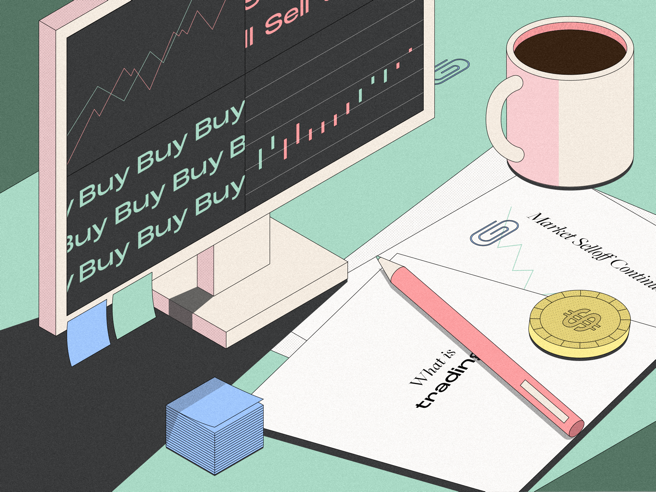Occasionally we’ll link out to relevant products that could be useful to our readers. Learn more about us here.
Mutual funds and exchange-traded funds (ETFs) are “cousins” in the investing world. Both give investors an ability to buy a diversified handful of securities with a single purchase.
But while mutual funds and ETFs may some similarities, they have more differences than commonalities, particularly when it comes to fees and the way they’re traded and constructed. When evaluating ETFs and/or mutual funds for your investment portfolio, it’s important to understand how each type of investment works.
Mutual funds vs. ETFs
Mutual funds pre-date ETFs, and have been around in Canada since the 1930s. Mutual funds pool the money from a large group of investors, and use that collective buying power to invest in a variety of stocks, bonds and other securities. A professional fund manager makes all the investing decisions with the goal of earning higher-then-benchmark returns. Mutual funds are sold as units, don’t trade on an exchange, which means they can only be bought and sold at the end of the day.
ETFs were created in Canada in 1990 as a way to give investors access to passive investments – an investment that holds the same securities in an index – versus funds run by active managers. Like mutual funds, (most) ETFs own shares in publicly listed companies, but unlike mutual funds, they’re traded on a stock exchange, just like a stock. Most mimic the same holdings as an underlying financial index, such as the S&P 500 or the S&P/TSX Composite Index. This lets investors buy into a diversified portfolio that delivers benchmark-like returns.
There are two main reasons as to why ETFs have taken off over the years. One is that because they’re not actively managed funds, they don’t need to charge as high a fee to operate the investment. In Canada, the average management expense ratio on a mutual fund is about 2% (so take 2% off any returns you make), while ETF fees can be as low as 0.01%. Some U.S-based ETFs even come with no fees.
Trade stocks commission-free and get a $10 cash bonus
Open a Wealthsimple Trade account to buy and sell thousands of stocks and ETFs commission-free. You’ll get a $10 cash bonus when you join.
Terms and conditions apply.
The second reason is that active managers have a notoriously difficult time beating their benchmark, in part because of their fees into their returns. So why pay for an active manager who delivers lower returns than the benchmark-tracking ETF?
Here are some other key differences between ETFs and mutual funds.
Buying and selling
When you invest in a mutual fund, you buy shares of the fund itself (called units). Units represent a proportional stake in the fund, but investors don’t directly own any of the investments. How much you can earn from a mutual fund depends on the fund’s overall performance, the proportion of units you own, and the percentage of management fees.
ETFs work more like stocks: they’re bought and sold in shares, and trade on stock exchanges. Unlike investments held in a mutual fund, ETF shares are purchased and held directly by the investor. An ETF’s performance is based on how well its underlying holdings perform, minus a (smaller) management fee.
Flexibility and control
For the investor, mutual funds are totally hands-off. The fund manager handles all the research and analysis, and has full control over choosing investments, setting the asset mix and rebalancing the fund’s portfolio.
With ETFs, it depends on how hands-on you want to be with managing your own investments. If you go the DIY route and manage your own portfolio using an online brokerage account, you can pick and choose your own ETFs. Discount brokerages have low trading fees for ETFs, around $0-$10 per trade (depending on the brokerage).
If you invest using a financial advisor or robo-advisor, they’ll help you choose an appropriate asset mix after assessing your risk tolerance and investing goals.
Trading
Mutual funds only trade once a day, after the markets close. In North America, markets trade on weekdays between 9:30 a.m. and 4 p.m. EST. Mutual fund units are priced at the end of the day based on net asset value (NAV), which is the total value of the fund’s assets and cash divided by the number of outstanding shares.
ETFs are like stocks, and can be bought and sold at any time throughout the trading day. Like stocks, the price of ETF shares can fluctuate. ETF shares have two prices: net asset value and market price, which is based on the bid (what buyers are willing to pay) and the ask (what sellers are willing to take for it).
Transparency
Mutual funds usually only disclose their general asset mix and top 10 holdings to investors. You can also find information about a mutual fund’s objectives and strategies, investment mix, top investments, risk rating, historical performance and returns by reading its fund facts and simplified prospectus.
ETFs are more transparent than mutual funds, and publish a complete list of their holdings on publicly accessible websites every day. But if you don’t like an ETF’s holdings, you can’t do anything about it—just like mutual funds, investors don’t have any say about what goes into an ETF.
Fees
As mentioned, fees can be a lot lower on ETFs than mutual funds. The less you pay in fees, the more money you can keep to yourself. Management fees are paid regardless of how the fund performs, so it’s up to you to decide whether the costs you’re paying are worth it. Mutual funds may also charge additional sales fees, such as front-end load (commission charged upfront) or back-end load (commission charged later).
Because ETFs replicate a benchmark index and don’t have a fund manager actively choosing what goes into the portfolio, they usually have much cheaper MERs than mutual funds. However, you should still keep an eye on fees and commissions when trading ETFs. Many online discount brokerages offer free ETF trades, but some charge by transaction (buying, selling or both).
Why choose an ETF over a mutual fund?
ETFs and mutual funds are often discussed together because they’re two branches of the same tree, but you don’t have to choose one or the other. Diversification is important in investing, and a healthy portfolio can include a mix of stocks, bonds, ETFs, mutual funds, cash and other securities in different proportions, depending on your financial plan and savings goals.
There are dozens of different types of ETFs and mutual funds, some of which share similar features. An ETF or mutual fund may track a specific sector or industry, asset class, currency or geographic region, or have a specific goal like cash flow or growth.
However, ETFs have a few advantages that account for their increasing popularity.
Accessible: ETFs offer many of the same diversification benefits of a mutual fund, but at a lower cost for new investors. Some mutual funds require a minimum investment to buy in (for example, anywhere from $1,000 to $5,000), but ETFs can be purchased by the share using an online brokerage account.
Tax efficient: ETFs are considered more tax-efficient than mutual funds. New mutual fund units are created each time additional people invest, so selling those shares means the issuer must redeem them back into the fund. This triggers a capital gain or capital loss for the investor, depending on whether you sold your units for more or less than you paid.
ETF shares don’t go through the same churn of constantly being created, issued and redeemed. ETFs trade more freely on exchanges, like stocks, so shares aren’t actually redeemed when they’re sold. This lowers your tax burden.
When you hold ETFs or mutual funds inside a registered account such as a tax-free savings account (TFSA), registered education savings plan (RESP), or registered retirement savings plan (RRSP), you won’t pay income tax on investment gains as long as that money stays in the plan.
What are the advantages of mutual funds over ETFs?
Canadian ETFs have outsold mutual funds over the last two years, but mutual funds still dominate in Canada in terms of total assets under management ($1.6 trillion at the end of 2019).
Canadian mutual funds are often criticized for their high fees and commissions, but professional management and oversight is still valuable to some investors. If you’re investing in a mutual fund portfolio that’s appropriate for your financial profile and feel you’re receiving good returns for the fees you pay, you don’t necessarily need to change your strategy just because mutual fund fees are higher.
Do ETFs outperform mutual funds?
Generally speaking, an ETF is designed to track and mimic the returns of an underlying market index, not outperform it. Most mutual funds, on the other hand, are actively managed with the goal of beating the market—if you’re paying up to 2.5% in management fees, hopefully you’re getting your money’s worth, right? But there are no guarantees in investing, and past performance doesn’t indicate future performance.
A well-managed mutual fund may outperform the average index-tracking ETF over the short term, but the likelihood of fund managers consistently beating the market year after year is slim. But actively managed funds may not necessarily realize higher returns in the short term, either—85% of Canadian equity fund managers underperformed the S&P/TSX Composite in 2019, for example.
It’s also important to note that not all ETFs are low-cost and passively managed. There are now a number of actively managed ETFs on the market, where a fund manager handles stock picking, allocation and rebalancing to try and beat a particular benchmark. ETFs aren’t all broad based, either—they can focus on particular sectors, commodities, foreign currencies or industries within a specific region/country. Double-check the fees before making a trade, because they may be higher for some actively managed and niche ETFs.
Another thing to keep in mind is volatility. ETFs and mutual funds that contain a broader scope of investments will be less vulnerable to market swings than ones that have a narrower base of investments and focus on a particular sector, industry or commodity. For example, if technology stocks are performing poorly, the value of a tech-based ETF will plummet.
ETFs were born out of mutual funds, and the two share a common goal of bundling a mix of securities to offer investors a more diversified portfolio. Even though they’re often compared and are functionally different, you don’t have to choose one or the other for your investment portfolio. Think about your investment goals, the risks of the particular funds you want to invest in, how active you want to be in managing your investments, and how fees will affect your savings over the long-term.











